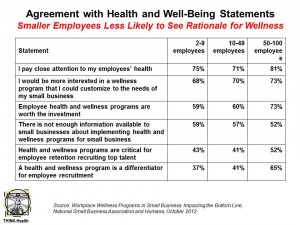
Nearly 50% of business start-ups view health and wellness as crucial to employee recruitment and retention. 31% of start-ups under 10 years of age have adopted wellness programs. Furthermore, 3 in 4 small companies that offer wellness programs say they positively impact the businesses’ bottom-lines.
Nonetheless, more than one-half of small business — companies with fewer than 100 employees — say that there isn’t enough information available that focuses squarely on wellness in small business.
These findings come from Workplace Wellness Programs in Small Business: Impacting the Bottom Line, a report from the National Small Business Association (NSBA) and Humana, details findings from their survey of 1,005 small business owners in the U.S., with employees number 2 to 100. Surveys were conducted in June and July 2012.
Most studies into workplace wellness have focused on large-sized employers. This study, sponsored by the NSBA, looks solely at smaller firms with fewer than 100 workers. Among ssmall companies, 93% of employers say that employee health is extremely (54%) or very (39%) important to the bottom line. Only 1% of small companies said employee health wasn’t very important, and only 6% said it was “somewhat important.” So small companies ccare deeply about employee health as a driver for profitability.
However, that being said, onlly 22% of small firms offer wellness programs. Furthermore, there’s a lack of confidence among most small companies regarding their ability to help their employees manage health and wellness.
The most concerning issues for employee well-being among small firms are:
- high stress levels, among 42%
- psychological well-being, for 13%
- weight management, 11%
- alcohol or other drug habits, 11%
- smoking habits, 9%.
Thus stress trumps all other health issues by a factor of more than 3:1
As the chart indicates, 3 in 4 small firms say they pay close attention to employee health, and at least 2 in 3 say they’d be keen on a wellness program that they could customize for the needs of small business. In addition, a majority of small firms believe that employee health and wellness programs are “worth the investment.” At the same time, though, most small companies don’t have enough information about implementing health and wellness programs specifically for small biz.
Among the minority of small companies who do offer wellness programs, 78% say that the programs positively impact the bottom-line. That’s because the biggest motivator in implementing a wellness program was rated as lowering long-term health costs followed by improving morale and increasing productivity — similar responses to HR managers in larger businesses.
And, like big business, smaller companies say the biggest barrier in implementing wellness in their firms is “lack of interest among employees,” noted by just under one-half of small cos.
Health Populi’s Hot Points: In many ways, small companies aren’t unlike their larger brethren when it comes to valuing the health of their workforces, and looking to lower health care costs. But small companies are more firmly focused on seeing employees manage stress more effectively.
Why? Because workers in smaller companies have fewer — you read that correctly, fewer — days out of work. And what’s the problem with that? Because workers in small firms come to work more often sick than workers in larger companies. Perhaps that’s because in smaller firms, people do more than one FTE of a job, or are spread thin in other ways. Whatever the reason, the NASB says this is the case.
The opportunity is clear enough: for population health management companies, health providers and accountable care organizations to address stress among workers in small companies. Evidence-based programs would be welcome by these employers, who generally haven’t been presented with sufficient data to make the case to adopt these programs. But it appears they want such programs, and they want them personalized for small business.
This could be a lovely opportunity for ACOs in local markets to work with community employers providing integrative health programs bringing together evidence-based programs for stress management. For example, there are data to back up claims supporting meditation and biofeedback for lowering high blood pressure, complemented by prescription drug programs (with generic drugs often being used to keep costs down in such regimens). In this instance, community-based care programs can address population health programs for small business quite effectively. THINK: Healthy Community, or in the mindset of an Accountable Care Community.





 I'm in amazing company here with other #digitalhealth innovators, thinkers and doers. Thank you to Cristian Cortez Fernandez and Zallud for this recognition; I'm grateful.
I'm in amazing company here with other #digitalhealth innovators, thinkers and doers. Thank you to Cristian Cortez Fernandez and Zallud for this recognition; I'm grateful. Jane was named as a member of the AHIP 2024 Advisory Board, joining some valued colleagues to prepare for the challenges and opportunities facing health plans, systems, and other industry stakeholders.
Jane was named as a member of the AHIP 2024 Advisory Board, joining some valued colleagues to prepare for the challenges and opportunities facing health plans, systems, and other industry stakeholders.  Join Jane at AHIP's annual meeting in Las Vegas: I'll be speaking, moderating a panel, and providing thought leadership on health consumers and bolstering equity, empowerment, and self-care.
Join Jane at AHIP's annual meeting in Las Vegas: I'll be speaking, moderating a panel, and providing thought leadership on health consumers and bolstering equity, empowerment, and self-care.